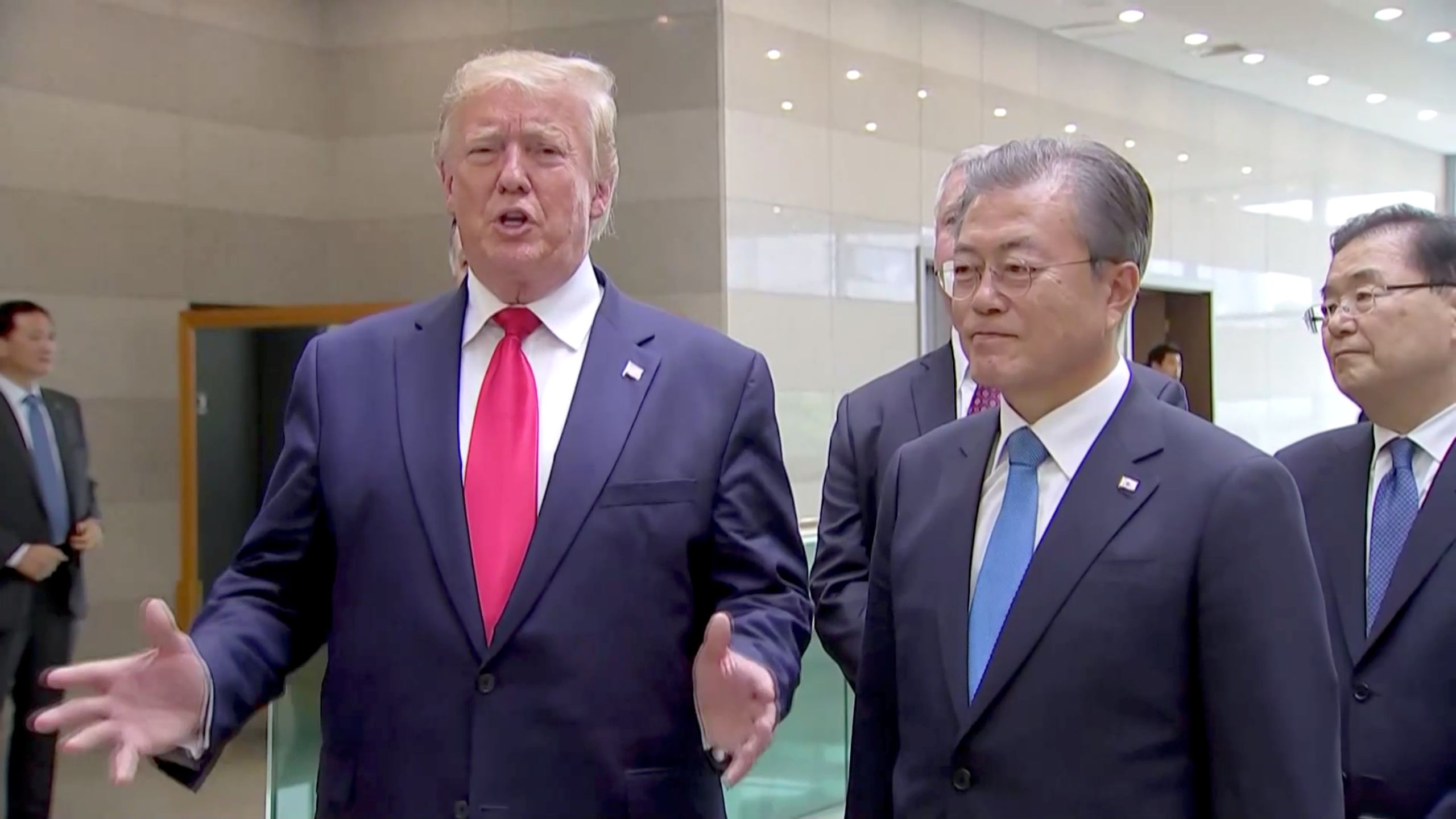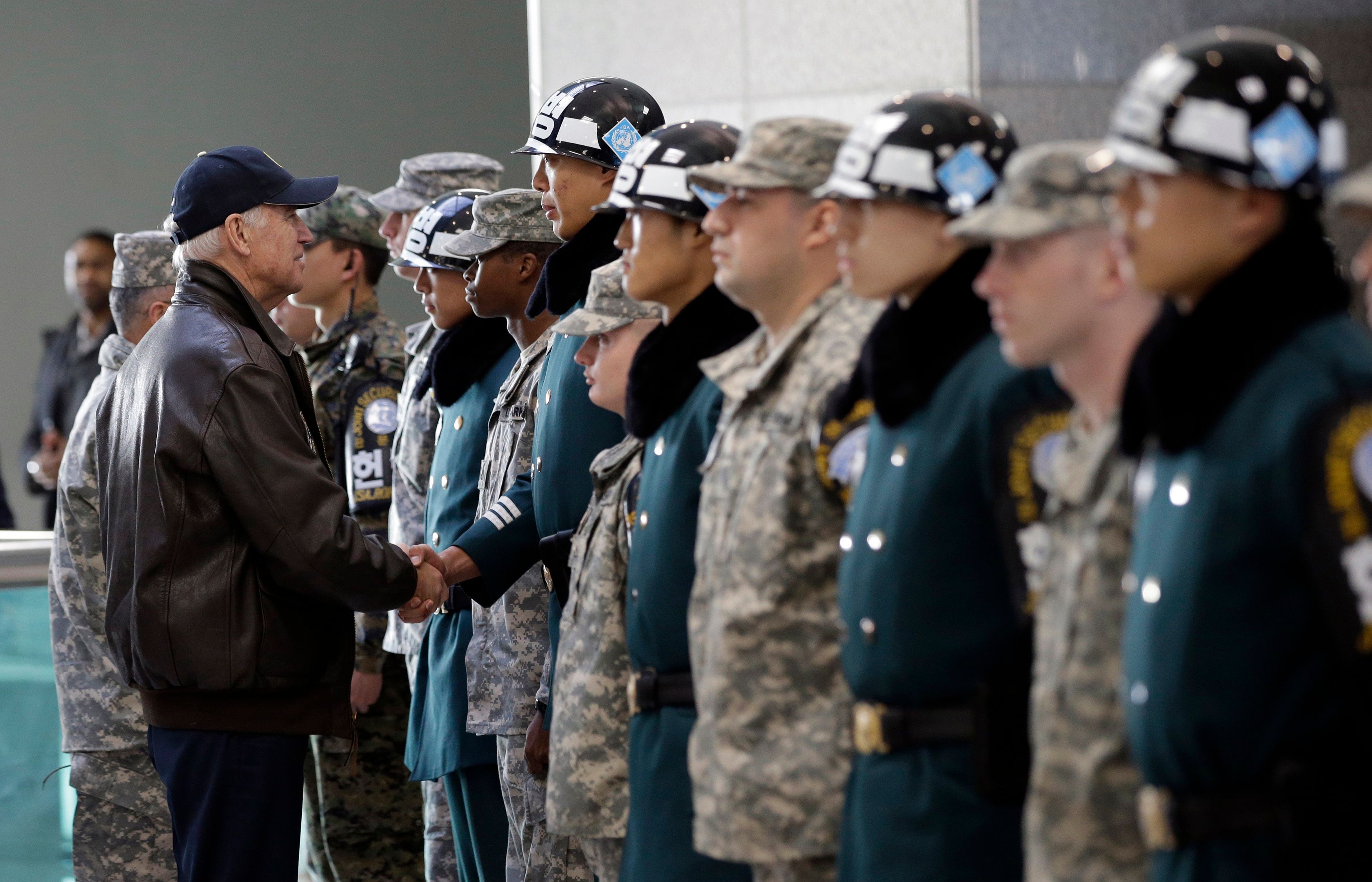U.S.-South Korea Alliance Challenged by Trump's Second Presidency
Donald Trump’s second presidency of the U.S. poses many challenges for South Korea. The United States may expect its ally to bear more of the costs of stationing U.S. troops on its territory and to participate more fully in its strategy of containing China. Relations may be complicated in the short term by the political crisis in South Korea and in the longer term by the likely early presidential election in the country. American pressure on South Korea will be an example of the new administration’s tactics towards other allies, including European ones.
.png) AA/ABACA / Abaca Press / Forum
AA/ABACA / Abaca Press / Forum
U.S. relations with South Korea improved after the tensions of Trump’s first term (2017-2021). The allies quickly agreed on the cost of stationing 28,500 U.S. troops on the Korean Peninsula (Special Measures Agreement, SMA) for 2020-2025 and strengthened defence cooperation in response to North Korean threats. The Yoon Suk-yeol administration, in charge of South Korea since 2022, has maintained a pro-American foreign policy orientation, including the announcement of its Indo-Pacific strategy and increased U.S.-Japan-South Korea cooperation. Last October, the allies concluded the 2026-2030 SMA, under which South Korea will pay $1.19 billion annually from 2026 (an increase of 8.3% from 2025).
The evolution of South Korea’s domestic situation, the definition of the terms of the alliance, South Korea’s stance on the U.S.-China rivalry, and the coordination of policies towards North Korea will be crucial for South Korea’s alliance with the U.S.
Internal Situation
The political crisis in South Korea triggered by Yoon’s declaration of martial law on 3 December last year is complicating relations between the allies. The impeachment of the president has left the South Korean government in a caretaker situation (the acting president is Choi Sang-mok, minister of economy and finance). This makes it difficult to establish relations with the new U.S. administration, especially official presidential contacts. The dynamic domestic political situation and the possibility of an early presidential election may also prevent South Korea from quickly entering into binding agreements with the U.S. An election would be held within 60 days of the Constitutional Court’s decision to impeach Yoon (it has until mid-June to do so). The results of the investigation into the imposition of martial law could also complicate allied relations if, for example, it is confirmed that Yoon’s government provoked tensions with the North for domestic political reasons, risking the outbreak of a conflict into which the U.S. could have been drawn.
Further complications could arise if a liberal opposition candidate wins the possible presidential election. According to polls at the end of January this year, Lee Jae-myung, the leader of the opposition Democratic Party with around 35% support, is the most likely to win. His victory could bring significant changes to South Korea’s foreign policy. Traditionally, liberals have been critical of dialogue with Japan, less clearly siding with the U.S. in its rivalry with China than conservatives, and more conciliatory towards North Korea.
Management of the Alliance and Economic Issues
The Trump administration is likely to demand that South Korea renegotiate the SMA, asking for up to several times the cost on the South Korean side. The U.S. can also expect the Koreans to increase their defence spending, which amounted to 2.8% of GDP in 2023, and to continue purchasing U.S. arms. To persuade its ally to change, the U.S. might threaten to reduce the frequency and scale of joint military exercises and to reduce or even withdraw American forces from South Korea.
The U.S. may also exert economic pressure on South Korea, which, according to the South’s data had a $55 billion surplus in goods trade with the U.S. in 2024. The Trump administration may threaten to impose tariffs on imports of South Korean goods, including on steel and aluminium, (along the lines of the restrictions imposed on China and imposed but delayed on Canada and Mexico) and force a renegotiation of the free trade agreement that came into force in 2012. Also problematic for South Korea could be Trump’s announced changes to the rules supporting electromobility in the U.S., including the removal of tax credits for buyers of electric vehicles (EVs) and support for companies investing in the development of the sector. Encouraged by the existing rules, South Korean manufacturers of EVs and batteries have made significant investments in the U.S. in recent years (including Hyundai Motor’s $12.6 billion project in Georgia).
The fact that the largest amount of foreign investment in the U.S. in 2023 came from South Korea ($21.5 billion, including in the automotive and chip manufacturing industries) could be an argument in negotiations with Trump not to impose tariffs on it. Shipbuilding cooperation also offers opportunities. A proponent is said to be Trump himself, and one of the things in South Korea’s favour is the fact that Hanwha Ocean has been providing ship maintenance, repair, and overhaul services to the U.S. Navy since last year. Moreover, in January this year, Westinghouse and Korea Hydro & Nuclear Power (KHNP) settled a dispute over intellectual property rights to nuclear technology, signalling a willingness to cooperate more closely on nuclear projects around the world.
South Korea and the U.S.-China Rivalry
The U.S. will want the alliance with South Korea to be a stronger tool in its rivalry with China. The Trump administration may view the presence of U.S. troops and bases on the Korean Peninsula in terms of their use in a possible conflict in the region, such as in the Taiwan Strait, and expect direct military support from South Korea. The U.S. will also press its ally to reduce economic ties with China and extend export control measures, especially in the chip sector. The U.S. has also signalled its willingness to continue trilateral cooperation with Japan and South Korea. The format, which in recent years has mainly served to deter North Korea, could become a tool for the Trump administration in its policy towards China.
From South Korea’s perspective, the U.S. demands on South Korea will raise concerns about a shift away from the alliance’s key role of deterring and defending against the North. South Korea may also be reluctant to antagonise China further for economic reasons. Although it has taken steps in recent years to diversify economic relations, including increasing exchanges with the U.S., China remains its largest trading partner. In 2024, South Korean exports to China amounted to $133 billion and imports to $140 billion (compared with exports to the U.S. of $128 billion and imports of $72 billion).
Policy towards North Korea
Coordinating the positions of South Korea and the U.S. on North Korea may also be a challenge. For now, the Trump administration’s plans in this regard are unclear. The president has vaguely signalled his willingness to resume talks with Kim Jong Un and has referred to the North as a nuclear state, which contradicts the previous policy of non-recognition of North Korea’s nuclear status by the U.S. and South Korea. Secretary of State Marco Rubio has described North Korea as a “rogue state” and White House statements indicate that the administration intends to pursue the denuclearisation of the North.
South Korea’s participation in possible U.S.-North Korea talks will be severely limited. The worst inter-Korean relations in years, as a result of their openly hostile policy towards each other, have led to a breakdown in communication channels. Kim Jong Un’s unequivocal rejection of the idea of inter-Korean dialogue will make it difficult to resume talks even if the liberals come to power in South Korea. The South may therefore be concerned that Trump’s talks with Kim will be conducted without its participation and that the decisions taken will be unfavourable to it. For example, they could address threats to the U.S. rather than South Korea (e.g., long-range ballistic missiles) and lead to a reduction in the scale and scope of joint drills.
Conclusions
Despite the similarities with the first Trump administration, the current challenges to South Korea’s alliance with the U.S. are more serious. The political situation in South Korea is more complicated than in 2017, when the president was also impeached. The international environment is also more challenging, including closer Sino-Russian cooperation, the North’s more developed military potential and its alliance with Russia. The most serious test for the U.S.-South Korea alliance will be the South’s stance on the U.S.-China rivalry.
The Trump administration’s approach to South Korea may illustrate an example of U.S. tactics towards other allies—including in Europe—that have a trade surplus with the U.S. and host American troops. The use of economic pressure can be used to force allies to change not only on economic issues but also on security issues. If the U.S. imposes tariffs on more countries, South Korea and the EU can intensify consultations to develop a joint response and develop cooperation on economic security, such as diversifying supply chains. The agreement between Westinghouse and KHNP could lead to cooperation between these companies in the construction of nuclear power plants in Poland.





.png)